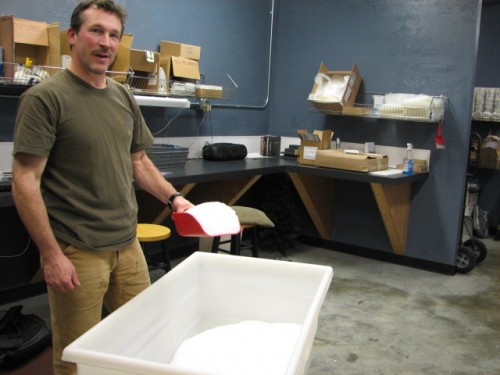
What do the Space Needle, Sitka Sound Science Center, and Cafe Juanita in Kirkland, Washington have in common? They all carry artisanal salt made by Alaska Pure. The Sitka company’s sea salts are designed around flavors reminiscent of Southeast Alaska. In 2013 their wild blueberry sea salt captured a national taste-test award.
The Egyptians revered the pyramid shape in part because they believed it to be the shape of the primordial mound from which the Earth was created.
Jim: This is where the salt gets made. [ROLLING DOOR UP]
Jim and Darcy Michener love the pyramid because…
Darcy: When you bite into it, it kind of yields a fine crunch.
It refers to artisanal finishing salt – the kind that’s sprinkled on a dish right before it’s served. Their attention to detail won the Micheners a national taste-testing award from Cooking Light magazine. The editors wrote:
“It’s hard to know which is more divine; this salt’s texture or its vivid hue. The gorgeous flat flakes are delicate on the palate, shattering beautifully with the faintest pressure. It’s nice, clean salt flavor has just a hint of fruity acidity. Equally striking sprinkled on scallops, dusted on a cookie or clinging to the rim of a margarita glass.”
Jim: If you look closely enough you can see little inverted pyramids floating on the surface. And they start out as a minuscule speck and they grow, and grow, and grow. When they get large enough and heavy enough they sink down to the bottom.
EF: And this is your day job? This is your everything right now?Jim: This is our everything.
Jim: So once the salt is made and we harvest, it drains.
EF: Ooo
Jim: And it just looks like freshly fallen snow.
EF: It looks like the kind of snow that if you were to visit Santa at the mall…
Jim: Yes, we think it would be great for movie sets.
The love affair with salt production started as a happy accident on their honeymoon. They left salt water evaporating on a wood stove too long and crystals formed. From then on it was long, slow, not always scientific process. Back breaking at times. For the first six years they lugged five gallon jugs of water from the harbor…
Jim: Ten five gallon jugs in the morning, ten five gallon jugs in the evening.
Everyday. The hard part was nailing down all the variables, and figuring out how to replicate the experiment for quality and consistency.
Jim: I would say its 70% science and 30% art. I mean it really is an art to learning what your salt is doing. Like a living thing, and nurturing it, making sure the conditions are right.
The Micheners described their first night after they made the leap to the large scale production facility that they operate now. They couldn’t make a single grain of salt. They say that night really tested their marriage
EF: I’m curious too in what ways this has shaped your relationship?
[SILENCE FOLLOWED BY LAUGHTER]
Jim: Uhh, good communication is key.
Jim and Darcy seem to have found the right balance – both with salt production and their partnership.
Jim handles the mechanics and Darcy handles taste – for instance how the blueberry salt finishes on your palate.
EF: Does the blueberry taste like blueberry?
Darcy: It does, if you don’t have a real discerning palate some people can’t pick that up. A lot of people will taste salt and say oh it tastes like salt. Well of course it tastes like salt first, you’re going to get salt first. But if you let it sit for a minute you will get a real bright acidity to it and a real berry flavor. It’s undeniable in my opinion.
What some might consider just flavored salt flakes, the Micheners believe are tiny monuments to the natural environment of Southeast Alaska. Pyramids for the Last Frontier.
Emily Forman is a reporter at KCAW in Sitka.




